
A new test can help detect cervical cancer early and track its progress easily, researchers reveal.
The plasma thermogram test works by analysing heat profile from a person's blood.
Creation of a plasma thermogram profile involves melting the blood plasma sample to generate a unique signature on the person's health status. The signature that includes all the major proteins in blood plasma is later measured using the thermoanalytical technique known as differential scanning calorimetry (DSC).
During their experiments, researchers from the University of Louisville in the US compared differences on the plasma thermogram profile of individuals, with and without the disease. Using a technique known as mass spectrometry, researchers succeeded in detecting biomarkers associated with the deadly disease in the blood plasma of people diagnosed with cervical cancer.
"We have been able to demonstrate a more convenient, less intrusive test for detecting and staging cervical cancer," Dr Nichola Garbett, said in a news release.
Garbett and colleagues proved effectiveness of the new test on 67 women suffering from cervical cancer, BBC reported.
The new inexpensive test is expected to help improve the currently available screening and treatments of the disease. "Comparing blood samples of patients who are being screened or treated against those thermograms should enable us to better monitor patients as they are undergoing treatment and follow-up. This will be a chance for us to adjust treatments so they are more effective," Garbett said.
Findings of the study reported in PLOS ONE are particularly important as the deadly disease claims lives of a significant number of women in India every year. Reports show that the disease strikes nearly 1,32,000 women every year, making 72,000 lose their lives.
In June last year, Indian researchers discovered that vinegar can be used to diagnose cervical cancer easily. The procedure involved swabbing the cervix with vinegar. Results showed that vinegar can turn any pre-cancerous tumours to white without taking much time. According to the reports, it helped reduce deaths related to cervical cancer in India by 31 percent.
Cervical cancer starts in the cervix, the lower part of the uterus. It is caused mainly by a virus known as HPV or the human papilloma virus. HPV is the virus that causes a sexually transmitted infection (STI) known as genital warts, or soft growths on the skin and mucus membranes of the genitals. HPV infection has also been known to cause vulvar cancer. Having safe sex and vaccinating against the virus are two options available to protect against developing the HPV infection. Though, in most of the cases women manage to eradicate the infection, in some cases the virus succeeds, leading to the development of cancer.
According to experts at Medline Plus, smoking, prolonged use of birth controls, HIV infection and giving multiple births can all increase the risk of cervical cancer. Having a history of multiple sexual partners, or engaging in sexual intercourse before age 15 are some other factors linked to the disease.















